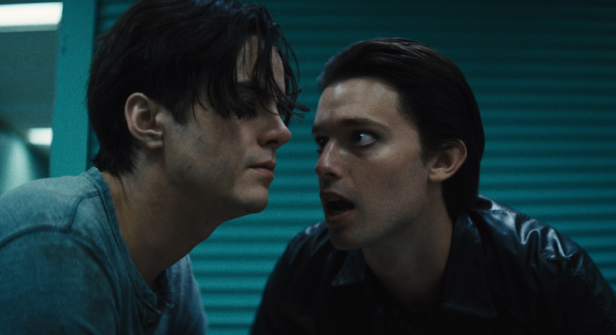The vengeful revenant at the heart of Adam Egypt Mortimer’s feature debut Some Kind Of Hate (2016), co-written with Brian DeLeeuw, embodies and enacts the darkest drives of the film’s living characters. In its follow-up, Daniel Isn’t Real, adapted by Mortimer from DeLeeuw’s 2009 novel In This Way I Saved, once again mental illness takes on tangible form as a character’s psychological architecture is reified as a monster of genre.
Like Ate De Jong’s Drop Dead Fred (1991) retold as a horror film, Daniel Isn’t Real sees the life of a young protagonist turned upside down as an imaginary childhood friend returns to play havoc. Sensitive student Luke (Miles Robbins) is working towards the realistic, rational option of law while still looking back wistfully at the photography which was once his passion and which he has now abandoned. His past haunts him in other ways too, as the relapse of his mother Claire (Mary Stuart Masterson) into bipolar delirium reawakens his concern that the legacy of her mental illness may be a ticking time bomb for himself. After all he did, as a child, experience a psychotic episode of his own, attempting, at the manipulative behest of his imaginary friend Daniel, to poison his manic mother. When demonic hallucinations send the now adult Luke to seek professional help, the psychiatrist Dr Cornelius Brown (Chukwudi Iwuji) urges him to conjure and confront Daniel once more – and Daniel (Patrick Schwarzenegger) is all too keen to be unleashed from his hiding place, and to take over Luke’s life and relationship with free-spirited artist Cassie (Sasha Lane).
The type of narrative that transforms a character’s animalistic, impulsive id into a character comes with a long tradition, from Robert Louis Stevenson’s 1886 novella The Strange Case of Dr Jekyll and Mr Hyde, through films like David Fincher’s Fight Club (1999), Bruce A. Evans’ Mr Brooks (2007), Yasuo Inoue’s The Neighbor No. 13 (2013), Till Kelienert’s Der Samurai (2014), Liam Regan’s My Bloody Banjo (2015) and Tini Tüllmann’s Freddy/Eddy (2016). In Daniel Isn’t Real, Daniel is Luke in negative – aggressive, appetitive and excessive where his host is meek, considerate, empathetic. At first Daniel is helpful to Luke, as their different traits complement each other and give Luke a new-found confidence and creativity. Yet soon the conflict between these two aspects of his personality reaches a critical point, as either one vies to control Luke’s flesh, giving rise to a schizophrenic fusion of psychodrama and body horror.
The film’s very title insists that Daniel is a figment, and indeed he is merely the fanciful incarnation of drives which Luke has been repressing ever since his traumatic childhood. On the other hand, there is a hint that Daniel may indeed be a real entity – a mostly invisible demon that passes from person to person, driving them to do unspeakable things and to create bloody ‘spectacle’. In other words, this is a film where the psychological, the supernatural and the metaphorical become inextricably confused. As Daniel Isn’t Real shows events from Luke’s subjectivised perspective, including a character whom nobody else can see and irrational locations that substitute for the labyrinthine corridors of his mind, we are never quite sure where the actual madness ends and the artistic imagery of its expression begins. For here, like in Ari Aster’s Hereditary (2018), the psychiatric and the Satanic do battle in a doll’s house that represents, in microcosm, the darkness that, as Cassie asserts, “we all have inside of us”, and that can easily drive any one of us over the edge. It is an astonishing, arresting film that constantly disorients any viewer who is trying to get a grip on its vying realities.
Daniel Isn’t Real was seen and reviewed at Arrow Video FrightFest 2019.
